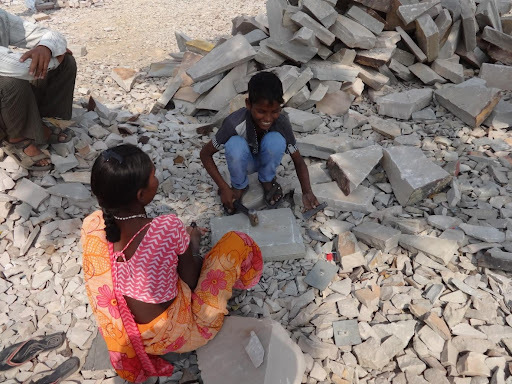
Background Context:
The Centre for Responsible Business (CRB), in partnership with UNICEF, conducted a study in the sandstone mining areas of Kota and Bundi, Rajasthan. The study aims to understand the socio-economic and working conditions of mine workers and propose ways to improve the well-being of families, especially children. By engaging stakeholders such as the industry, government, and civil society, the study seeks to strengthen child protection policies in mining regions.
Focusing on the mining sector’s business and regulatory environment, the report examines labor welfare, social protection, child labor, and the factors driving child involvement in mining. Data was gathered through qualitative research, including field observations and stakeholder interviews.
The study provides insights into the mining industry, labor policies, and working conditions, highlighting the role of women and children. It assesses regulatory standards and initiatives from the perspectives of government, industry, civil society, and labor to address these critical issues.
Objectives
The objectives of the assessment were as follows:
- An understanding of the operational context for business and identification of vulnerabilities where children may get involved; specifically, an understanding of the following:
- Organization, context and supply chain in sandstone mining, specifically in Kota and Bundi districts of Rajasthan; involvement of labor and children; and the impact of the buyers and international market on the industry;
- The regulatory context’ in which mines operate, with specific focus on labor engagement and engagement of children
- The risk and vulnerabilities of labor, families and children engaged in mines
- The policies and available mechanisms of social protection and benefits for labor, families and children engaged in mines (wage and job security; insurance; right to education, in case of children etc.)
- The attitude and perspectives of key stakeholders on issues of mining, labor engagement in mining, child labor in mines, risks and vulnerabilities, mechanisms of social protection for labor and addressing issues and rights of children in labor
- Any initiatives/ strategies/ remedial measures undertaken by various stakeholders (government, civil society, business houses, employers etc.) to address issues child labor and rights; and reduce risks/ vulnerabilities and barriers faced by children in labor and their families
- Assess the effort and commitment of employers/businesses in working towards addressing issues such as education, mechanisms of social protection and benefits for families, and other ‘push factors’ for child labor; effort and commitment towards addressing issues of child rights
- Document available national/ international codes and practices for addressing issues of children in labor; identifying benchmark initiatives and studies
- The study aims to understand the operational landscape of the sandstone mining industry in Kota and Bundi, Rajasthan, and identify vulnerabilities where children may be drawn into labor. Key areas of focus include:
- Industry Structure and Supply Chain: Analyzing the organization of the sandstone mining sector, the role of labor and children, and the influence of buyers and international markets on the industry.
- Regulatory Framework: Examining the legal and regulatory context in which mines operate, with emphasis on labor practices and child involvement in mining.
- Labor and Child Vulnerabilities: Assessing the risks and vulnerabilities faced by workers, families, and children engaged in mining activities.
- Social Protection Policies: Evaluating the availability of social protection mechanisms for workers and families, such as wage and job security, insurance, and children's rights to education.
- Stakeholder Perspectives: Exploring the attitudes of key stakeholders—including government, businesses, and civil society—toward mining practices, labor engagement, child labor, and social protection measures for families.
- Initiatives to Address Child Labor: Reviewing strategies and initiatives by various stakeholders aimed at reducing child labor, mitigating risks and vulnerabilities, and protecting the rights of children and families involved in mining.
- Employer Commitment: Assessing the efforts of businesses to address issues like education, social protection, and other factors driving child labor, as well as their commitment to safeguarding child rights.
- Benchmark Practices: Documenting national and international best practices and standards for addressing child labor in mining, identifying leading initiatives and studies that can serve as benchmarks for improvement.
Approach and Methodology
Qualitative methods were used for data collection.
- In-depth interviews – With industry stakeholders including mine managers, laborers, contractors, processing units, exporters etc. to understand aspects of the supply chain, labor engagement, living and working conditions of labor, challenges and their perspectives on issues in the industry, and specifically on children in labor - With government stakeholders to understand the regulatory context in mining, policies and laws and their implementation, labor issues and issues of child labor and their perspectives - With civil society representatives and stakeholders from non-government organizations to understand perspectives on issues of labor and children in labor in mining; and some of the efforts they have made to address this issue
- Focus group discussions – with women and children engaged in mining and/or living in the mining communities, to understand from them the living and working conditions of labor in mining, access to healthcare, education and other social benefits and their perspectives on the issues and challenges in mining
- Informal interactions and group discussions – with stakeholders across the supply chain in mining, to understand the activities and tasks in the mining supply-chain; involvement, role and responsibilities of stakeholders; issues and challenges
- Observation – of labor undertaking tasks involved in mining; and execution of mining activities
- Desk review – to understand the overall context in sandstone mining – supply chain, policies and regulation, standards and benchmarks, ethical practices etc.; as well as understand issues and challenges in mine labor engagement and child labor in mining Sample
Given the focus of the study, most of the interactions were held with stakeholders involved directly in mining activities in the Kota-Bundi region. In addition stakeholders from government and civil society were met in Kota-Bundi, Jaipur, Jodhpur and Delhi. For details- refer to report attached.
Impact
The insights from the study were disseminated to key stakeholders - including the industry and government departments in Rajasthan. The study findings informed the clients industry engagement strategy on ethical supply chains in stone mining.
